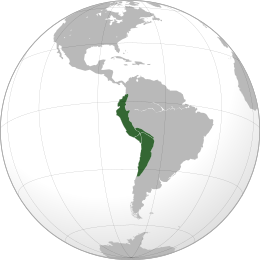More languages
More actions
| Realm of the Four Parts Tawantinsuyu | |
|---|---|
| 1438–1533 | |
|
Royal emblem | |
 The empire at its peak in 1525 | |
| Capital | Cusco |
| Official languages | Quechua |
| Government | Absolute monarchy |
| Area | |
• Total | 2,000,000 km² |
The Inca Empire, officially the Realm of the Four Parts, was a precolonial state in South America. It relied on a large professional army and an administrative bureaucracy. Despite only having Stone Age means of production, it was able to construct a 40,000-km road system and large monuments such as Machu Picchu.[1] It integrated its agricultural system on a national scale and retained communal elements that enabled a good standard of living for its population.[2]
According to José Carlos Mariátegui, the Inca Empire and socialism shared some features.[3]
Inca rule was very unpopular, and the empire easily fell to Spanish invaders in the 16th century.[1] The Spanish soon proved to be much more brutal than the Inca rulers and created a feudal system under a colonial viceroy.[2]
References
- ↑ 1.0 1.1 Neil Faulkner (2013). A Marxist History of the World: From Neanderthals to Neoliberals: 'The Medieval World' (pp. 72–73). [PDF] Pluto Press. ISBN 9781849648639 [LG]
- ↑ 2.0 2.1 Sergio Rodriguez Gelfenstein (2020-12-18). "How long will Peru last? History weighs on today’s events" Workers World. Archived from the original on 2023-06-06.
- ↑ Mike Gonzalez (2023-02-14). "José Carlos Mariátegui Was the Great Pioneer of Latin American Marxism" Jacobin.

